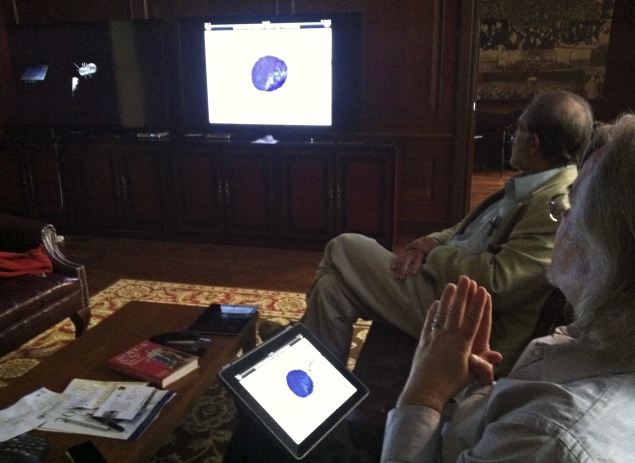- Home
- Others
- Others News
- An Inception style machine to decode your dreams
An Inception-style machine to decode your dreams

Scientists have designed the world's first inception-style 'dream reader' that can decode your dreams with reasonable accuracy.
In the Leonardo DiCaprio starrer Inception, people manipulate other people's dreams and steal their sleeping thoughts.
In a new study, neuroscientist Yukiyasu Kamitani and colleagues at the Advanced Telecommunications Research Institute International in Kyoto, Japan monitored three young men as they tried to get some sleep inside an fMRI scanner while the machine monitored their brain activity.
Researchers also monitored each volunteer's brain activity with EEG electrodes, and when they saw an EEG signature indicative of dreaming, they woke him up to ask what he'd been dreaming about.
Researchers call it "hypnagogic imagery," the dream-like state that occurs as people fall asleep.
They woke up each subject at least 200 times over the course of several days to build up a database of dream reports, website 'wired.com' reported.
Kamitani and colleagues then developed a visual imagery decoder based on machine learning algorithms.
They trained the decoder to classify patterns of brain activity recorded from the same three men while they were awake and watching a video montage of hundreds of images selected from several on-line databases.
After the decoder for each person had been trained, the researchers could input a pattern of brain activity and have the decoder predict which image was most likely to have produced that pattern of brain activity.
Kamitani's team went beyond previous work in feeding the decoder patterns of brain activity collected while the subjects were dreaming.
This enabled them to correctly identify objects the men had seen in their dreams, they report in journal Science.
They could identify the type of object a subject had seen, it could predict that a man had dreamt about a car, not that he'd been cruising around in a Maserati.
And the decoder only worked when the researchers gave it a pair of possible objects to chose from.
"Our dream decoding is still very primitive," Kamitani said.
Decoding colour, action, or emotion is also still beyond the scope of the technology, Kamitani says. Also, it only seems to work for imagery that occurred at most about 15 seconds before waking up.
Finally, the decoder is unique to each person. To decode the dreams of another person, the team would have to train up a new decoder by having that person view hundreds of images.
With refinements, Gallant says the method could be useful for studying the nature and function of dreams.
For the latest tech news and reviews, follow Gadgets 360 on X, Facebook, WhatsApp, Threads and Google News. For the latest videos on gadgets and tech, subscribe to our YouTube channel. If you want to know everything about top influencers, follow our in-house Who'sThat360 on Instagram and YouTube.
Related Stories
- Samsung Galaxy Unpacked 2025
- ChatGPT
- Redmi Note 14 Pro+
- iPhone 16
- Apple Vision Pro
- Oneplus 12
- OnePlus Nord CE 3 Lite 5G
- iPhone 13
- Xiaomi 14 Pro
- Oppo Find N3
- Tecno Spark Go (2023)
- Realme V30
- Best Phones Under 25000
- Samsung Galaxy S24 Series
- Cryptocurrency
- iQoo 12
- Samsung Galaxy S24 Ultra
- Giottus
- Samsung Galaxy Z Flip 5
- Apple 'Scary Fast'
- Housefull 5
- GoPro Hero 12 Black Review
- Invincible Season 2
- JioGlass
- HD Ready TV
- Laptop Under 50000
- Smartwatch Under 10000
- Latest Mobile Phones
- Compare Phones
- Itel A90
- Nubia Z70S Ultra
- Meizu Note 16
- Meizu Note 16 Pro
- Sony Xperia 1 VII
- OnePlus 13s
- Samsung Galaxy S25 Edge
- Vivo Y300 GT
- Lenovo Legion 9i (18”, 10)
- Alienware 16X Aurora
- OnePlus Pad 2 Pro
- Amazon Kindle Paperwhite (12th Gen)
- boAt Storm Infinity Plus
- Moto Watch Fit
- Xiaomi QLED TV FX Pro (55-inch)
- Xiaomi QLED TV FX Pro
- Asus ROG Ally
- Nintendo Switch Lite
- Toshiba 1.8 Ton 5 Star Inverter Split AC (RAS-24TKCV5G-INZ / RAS-24TACV5G-INZ)
- Toshiba 1.5 Ton 5 Star Inverter Split AC (RAS-18PKCV2G-IN / RAS-18PACV2G-IN)

















